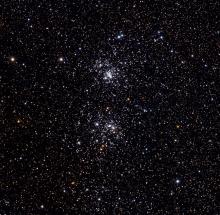Listen to today's episode of StarDate on the web the same day it airs in high-quality streaming audio without any extra ads or announcements. Choose a $8 one-month pass, or listen every day for a year for just $30.
You are here
Xi Persei
Xi Persei doesn’t look all that imposing. The star shines at fourth magnitude, so it’s visible under dark skies, but not from light-polluted cities and towns. But that’s only because it’s a long way off — about 1200 light-years. In reality, it’s one of the most impressive stars visible to the human eye.
Perseus climbs the eastern sky on autumn nights. It consists of a couple of ribbons of stars that join at Mirfak, the constellation’s leading light. And it contains the most famous variable star in the sky: Algol, the Demon Star, which gets noticeably fainter every three days or so.
Yet neither star can compare with Xi Persei, which is near the bottom of the longer ribbon of stars. At visible wavelengths, it’s about 13,000 times brighter than the Sun. But the star is tens of thousands of degrees hotter than the Sun, so it emits most of its light at ultraviolet wavelengths. When you add that in, Xi Persei is a quarter of a million times the Sun’s brightness.
The key to that showiness is the star’s mass — about 30 times that of the Sun. The star’s powerful gravity squeezes its core tightly, revving up its nuclear reactions. The energy from those reactions works its way to the surface, making Xi Persei hot and bright.
And before long, it’ll get even hotter and brighter. It’ll blast itself apart as a supernova, briefly shining brighter than billions of normal stars — a brilliant demise for an impressive star.
More about Perseus tomorrow.
Script by Damond Benningfield




